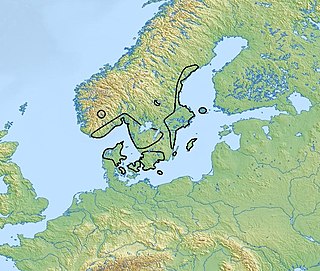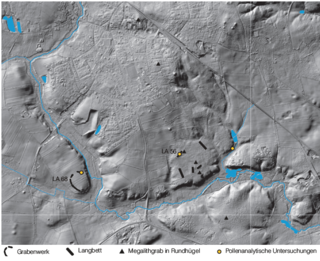
The Neolithic or New Stone Age is an archaeological period, the final division of the Stone Age in Europe, Asia and Africa. It saw the Neolithic Revolution, a wide-ranging set of developments that appear to have arisen independently in several parts of the world. This "Neolithic package" included the introduction of farming, domestication of animals, and change from a hunter-gatherer lifestyle to one of settlement. The term 'Neolithic' was coined by Sir John Lubbock in 1865 as a refinement of the three-age system.
The 3rd millennium BC spanned the years 3000 to 2001 BC. This period of time corresponds to the Early to Middle Bronze Age, characterized by the early empires in the Ancient Near East. In Ancient Egypt, the Early Dynastic Period is followed by the Old Kingdom. In Mesopotamia, the Early Dynastic Period is followed by the Akkadian Empire. In what is now Northwest India and Pakistan, the Indus Valley civilization developed a state society.

The Corded Ware culture comprises a broad archaeological horizon of Europe between c. 3000 BC – 2350 BC, thus from the late Neolithic, through the Copper Age, and ending in the early Bronze Age. Corded Ware culture encompassed a vast area, from the contact zone between the Yamnaya culture and the Corded Ware culture in south Central Europe, to the Rhine in the west and the Volga in the east, occupying parts of Northern Europe, Central Europe and Eastern Europe. Early autosomal genetic studies suggested that the Corded Ware culture originated from the westward migration of Yamnaya-related people from the steppe-forest zone into the territory of late Neolithic European cultures; however, paternal DNA evidence fails to support this hypothesis, and it is now proposed that the Corded Ware culture evolved in parallel with the Yamnaya, with no evidence of direct male-line descent between them.

The Bell Beaker culture, also known as the Bell Beaker complex or Bell Beaker phenomenon, is an archaeological culture named after the inverted-bell beaker drinking vessel used at the very beginning of the European Bronze Age, arising from around 2800 BC. Bell Beaker culture lasted in Britain from c. 2450 BC, with the appearance of single burial graves, until as late as 1800 BC, but in continental Europe only until 2300 BC, when it was succeeded by the Unetice culture. The culture was widely dispersed throughout Western Europe, being present in many regions of Iberia and stretching eastward to the Danubian plains, and northward to the islands of Great Britain and Ireland, and was also present in the islands of Sardinia and Sicily and some coastal areas in north-western Africa. The Bell Beaker phenomenon shows substantial regional variation, and a study from 2018 found that it was associated with genetically diverse populations.

Archaeology and geology continue to reveal the secrets of prehistoric Scotland, uncovering a complex past before the Romans brought Scotland into the scope of recorded history. Successive human cultures tended to be spread across Europe or further afield, but focusing on this particular geographical area sheds light on the origin of the widespread remains and monuments in Scotland, and on the background to the history of Scotland.

The Funnel(-neck-)beaker culture, in short TRB or TBK, was an archaeological culture in north-central Europe. It developed as a technological merger of local neolithic and mesolithic techno-complexes between the lower Elbe and middle Vistula rivers. These predecessors were the (Danubian) Lengyel-influenced Stroke-ornamented ware culture (STK) groups/Late Lengyel and Baden-Boleráz in the southeast, Rössen groups in the southwest and the Ertebølle-Ellerbek groups in the north. The TRB introduced farming and husbandry as major food sources to the pottery-using hunter-gatherers north of this line.

The Pitted Ware culture was a hunter-gatherer culture in southern Scandinavia, mainly along the coasts of Svealand, Götaland, Åland, north-eastern Denmark and southern Norway. Despite its Mesolithic economy, it is by convention classed as Neolithic, since it falls within the period in which farming reached Scandinavia. The Pitted Ware people were largely maritime hunters, and were engaged in lively trade with both the agricultural communities of the Scandinavian interior and other hunter-gatherers of the Baltic Sea.

The Battle Axe culture, also called Boat Axe culture, is a Chalcolithic culture that flourished in the coastal areas of the south of the Scandinavian Peninsula and southwest Finland, from c. 2800 BC – c. 2300 BC. It was an offshoot of the Corded Ware culture, and replaced the Funnelbeaker culture in southern Scandinavia, probably through a process of mass migration and population replacement. It is thought to have been responsible for spreading Indo-European languages and other elements of Indo-European culture to the region. It co-existed for a time with the hunter-gatherer Pitted Ware culture, which it eventually absorbed, developing into the Nordic Bronze Age. The Nordic Bronze Age has, in turn, been considered ancestral to the Germanic peoples.
The Narva culture or eastern Baltic was a European Neolithic archaeological culture in present-day Estonia, Latvia, Lithuania, Kaliningrad Oblast, and adjacent portions of Poland, Belarus and Russia. A successor of the Mesolithic Kunda culture, the Narva culture continued up to the start of the Bronze Age. The culture spanned from c. 5300 to 1750 BC. The technology was that of hunter-gatherers. The culture was named after the Narva River in Estonia.

Prehistoric France is the period in the human occupation of the geographical area covered by present-day France which extended through prehistory and ended in the Iron Age with the Roman conquest, when the territory enters the domain of written history.

The prehistory of Ireland has been pieced together from archaeological evidence, which has grown at an increasing rate over the last decades. It begins with the first evidence of permanent human residence in Ireland around 10,500 BC and finishes with the start of the historical record around 400 AD. Both the beginning and end dates of the period are later than for much of Europe and all of the Near East. The prehistoric period covers the Palaeolithic, Mesolithic, Neolithic, Bronze Age and Iron Age societies of Ireland. For much of Europe, the historical record begins when the Romans invaded; as Ireland was not invaded by the Romans its historical record starts later, with the coming of Christianity.

The Single Grave culture was a Chalcolithic culture which flourished on the western North European Plain from ca. 2,800 BC to 2,200 BC. It is characterized by the practice of single burial, the deceased usually being accompanied by a battle-axe, amber beads, and pottery vessels. The Single Grave culture was a local variant of the Corded Ware culture, and appears to have emerged as a result of a migration of peoples from the Pontic–Caspian steppe. It was succeeded by the Bell Beaker culture, which according to the "Dutch model" appears to have been ultimately derived from the Single Grave culture. More recently, the accuracy of this model has been questioned.

Prehistory in the Iberian peninsula begins with the arrival of the first Homo genus representatives from Africa, which may range from c. 1.5 million years (Ma) ago to c. 1.25 Ma ago, depending on the dating technique employed, so it is set at c. 1.3 Ma ago for convenience. The end of Iberian prehistory coincides with the first entrance of the Roman army into the peninsula, in 218 before Christ (BC), which led to the progressive dissolution of pre-Roman peoples in Roman culture. This end date is also conventional, since pre-Roman writing systems can be traced to as early as 5th century BC.
The Wartberg culture, sometimes: Wartberg group (Wartberggruppe) or Collared bottle culture (Kragenflaschenkultur) is a prehistoric culture from 3,600 -2,800 BC of the later Central European Neolithic. It is named after its type site, the Wartberg, a hill near Niedenstein-Kirchberg in northern Hesse, Germany.

Human habitation of present-day Sweden began c. 12000 BC. The earliest known people belonged to the Bromme culture of the Late Palaeolithic, spreading from the south at the close of the Last Glacial Period. Neolithic farming culture became established in the southern regions around 4000 BC, but much later further north. About 1700 BC the Nordic Bronze Age began in the southern regions, based on imported metals; this was succeeded about 500 BC by the Iron Age, for which local ore deposits were exploited. Cemeteries are known mainly from 200 BC onward.

The Stone Age in the territory of present-day Poland is divided into the Paleolithic, Mesolithic, and Neolithic eras. The Paleolithic extended from about 500,000 BCE to 8000 BCE. The Paleolithic is subdivided into periods, the Lower Paleolithic, 500,000 to 350,000 BCE, the Middle Paleolithic, 350,000 to 40,000 BCE, the Upper Paleolithic, 40,000 to 10,000 BCE, and the Final Paleolithic, 10,000 to 8000 BCE. The Mesolithic lasted from 8000 to 5500 BCE, and the Neolithic from 5500 to 2300 BCE. The Neolithic is subdivided into the Neolithic proper, 5500 to 2900 BCE, and the Copper Age, 2900 to 2300 BCE.
The European Chalcolithic, the Chalcolithic period of Prehistoric Europe, lasted roughly from 5000 to 2000 BC, developing from the preceding Neolithic period and followed by the Bronze Age.
The Neolithic creolisation hypothesis, first put forward by Marek Zvelebil in 1995, situates the Proto-Indo-European Urheimat in northern Europe in Neolithic times at the Baltic coast, proposing that migrating Neolithic farmers mixed with indigenous Mesolithic hunter-gatherer communities, resulting in the genesis of the Indo-European language family.

The prehistory of the Netherlands was heavily influenced by the region's constantly changing, low-lying geography. Inhabited by humans for at least 37,000 years, the landscape underwent significant transformations, from the last ice age's tundra climate to the emergence of various Paleolithic groups. The region witnessed the development of the Swifterbant culture, which was closely linked to rivers and open water, while the Mesolithic era saw the creation of the world's oldest recovered canoe, the Pesse canoe. The arrival of agriculture around 5000–4000 BC marked the beginning of the Linear Pottery culture, which gradually transformed prehistoric communities.

The site Albersdorf-Dieksknöll LA 68 is a causewayed enclosure of the fourth millennium BC in Albersdorf, district Dithmarschen, northern Germany. It is one of the three or four known enclosure sites in Schleswig-Holstein and of the 47 known causewayed enclosure of the Funnel Beaker Culture.















